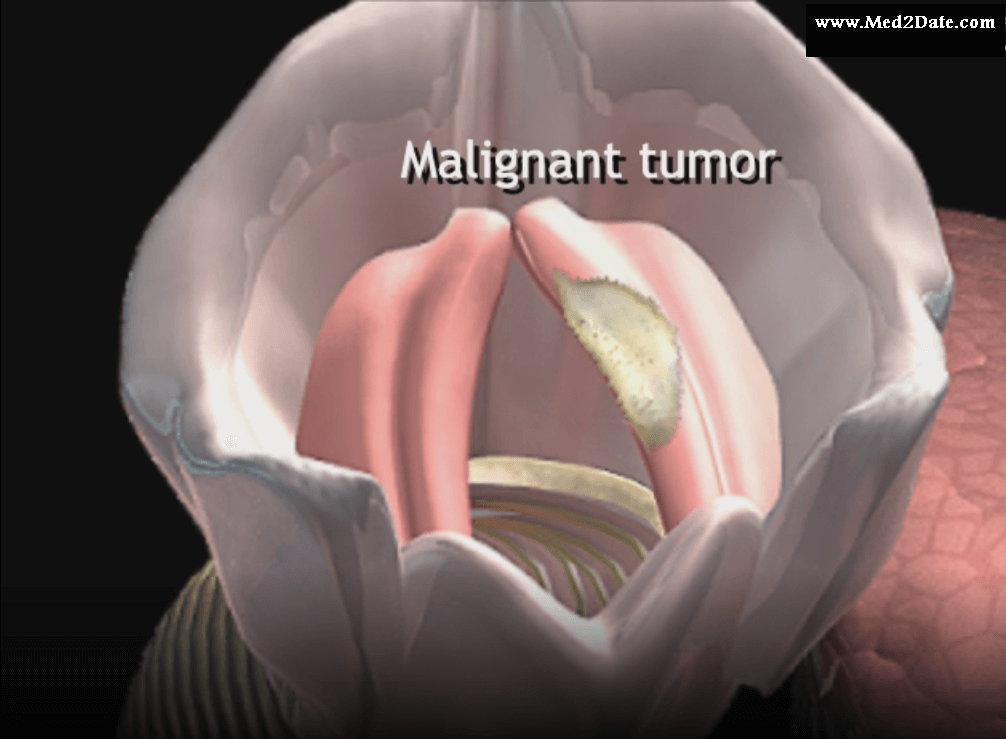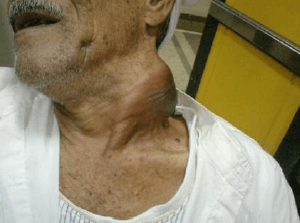Definition: Malignant tumor of the larynx (voice box).
Incidence:
Clinical: Malignant ulcer, fungating mass, or infiltrating nodule.
Spread:
1. Direct, to adjacent areas, tongue base, or trachea.
2. Lymphatic spread.
A. Glottic: very rare, as there is no lymphatics in Reinke’s space.
B. Supraglottic: common & early due to rich lymphatics >> UDCLN.
C. Subglottic: common may be bilateral >> pre laryngeal, pre tracheal, paratracheal >> middle & LDCLN.
3- Blood spread rare & late: lungs, liver, bone, brain.
Tis Carcinoma in situ.
T1 One region (in glottic T1a : one cord, T1b : two cords).
T2 Two regions.
T3 Fixed cord.
T4 Extra laryngeal spread.
N: Nodes
N0: No cervical lymph nodes positive.
N1: Single ipsilateral lymph node ≤ 3cm.
N2a: Single ipsilateral node > 3cm and ≤6cm.
N2b: Multiple ipsilateral lymph nodes, each ≤ 6cm.
N2c:Bilateral lymph nodes ≤ 6cm.
N3: Single or multiple lymph nodes > 6cm.
M: Distant metastasis
M0: No clinical or radiological evidence of metastasis.
M1: Present clinical or radiological evidence of metastasis.
Incidence:
- Age: most common age at presentation is 40 to 70 years.
- Gender: male to female 10 to 1, (now it is about 7 to 1)
- Larynx cancer is more prevalent among lower socioeconomic groups.
Risk factors for Laryngeal SCC
- Exposure to human papillomavirus (HPV)
- Tobacco use. Both active & passive smoking are harmful. There is 13-fold risk for laryngeal cancer for smokers
- Alcohol consumption. Alcohol is thought to promote carcinogenesis.
- The combination of smoking and alcohol (tabagism) use has a more than additive carcinogenic effect on the larynx (synergistic effect).
- Chronic Gastric Reflux
- Prior history of head and neck irradiation.
- Occupational exposures: Several types of industrial agents and toxic inhalants are carcinogenic such as (tar, nickel, heat, and asbestos).
- Leukoplakia and adult papilloma.
Pathology:
- Site: Glottic Carcinoma: 59%, Supraglottic Cancer: 40%, and subglottic Cancer 1%.
- Histological Types: 85-95% of laryngeal tumors are squamous cell carcinoma. Other types include verrucous carcinoma, fibrosarcoma, chondrosarcoma, adenocarcinoma and others.
Clinical: Malignant ulcer, fungating mass, or infiltrating nodule.
Spread:
1. Direct, to adjacent areas, tongue base, or trachea.
2. Lymphatic spread.
A. Glottic: very rare, as there is no lymphatics in Reinke’s space.
B. Supraglottic: common & early due to rich lymphatics >> UDCLN.
C. Subglottic: common may be bilateral >> pre laryngeal, pre tracheal, paratracheal >> middle & LDCLN.
3- Blood spread rare & late: lungs, liver, bone, brain.
Staging of laryngeal carcinoma
T for primary tumorTis Carcinoma in situ.
T1 One region (in glottic T1a : one cord, T1b : two cords).
T2 Two regions.
T3 Fixed cord.
T4 Extra laryngeal spread.
N: Nodes
N0: No cervical lymph nodes positive.
N1: Single ipsilateral lymph node ≤ 3cm.
N2a: Single ipsilateral node > 3cm and ≤6cm.
N2b: Multiple ipsilateral lymph nodes, each ≤ 6cm.
N2c:Bilateral lymph nodes ≤ 6cm.
N3: Single or multiple lymph nodes > 6cm.
M: Distant metastasis
M0: No clinical or radiological evidence of metastasis.
M1: Present clinical or radiological evidence of metastasis.
Symptoms of cancer larynx
- Hoarseness or dysphonia: Persistent hoarseness in an old male for 2-3 weeks is suspicious for carcinoma.
- Stridor: It is the early symptom which may alter the attention to subglottic carcinoma.
- Pain: referred otalgia: may result from ulcer over the inlet of the larynx or perichondritis.
- Dysphagia: common in supraglottic lesions.
- Neck mass : mostly lymph nodes.
Signs:
I. General:
Teeth for sepsis & oral hygiene.
Chest : distant metastasis.
II. Local: (Larynx)
1-External (Neck): Lymph nodes, swelling, broadening, tenderness, and thyroid cartilage.
2-By Indirct Laryngoscopy, flexible or Direct Laryngoscopy examination:
Tumor: Hyperkeratotic warty or papillary growth, malignant ulcer, or raised nodule.
V.C mobility:
- Freely mobile.
- Fixed: deep muscle invasion.
- Limited: weight of tumor or moderate invasion
Extension: to hypopharynx, trachea or tongue.
NB: some areas are difficult to be examined: ventricle, subglottis, posterior surface of epiglottis.
Investigations:
1- Radiology:
Chest X Ray
CT scan: to detect cartilage invasion, extra laryngeal spread and subglottic extension.
MRI: Superior than CT scan in demonstrating soft tissue involvement.
2-DL: Site, extent, and biopsy.
3-Metastatic work up. (Chest X ray, abdominal sonar & bone scan).
4-Routine preoperative investigations.
Treatment of cancer larynx:
Tis stage:
Surgery: carcinomatous transformation, without basal membrane penetration. .
- Complete excision Conservative management: stripping of VC
- Frequent follow up and re biopsy 6 to 12 weeks later.
- There is no role for radiotherapy.
T1 Laryngeal Cancer:
- Radiation therapy.
- Endoscopic laser microsurgery.
- Partial laryngectomy (vertical in glottis, and horizontal in supraglottis).
- In subglottic, either radiotherapy, or total laryngectomy.
T2 Laryngeal Cancer:
- Radiation therapy.
- Endoscopic laser microsurgery.
- Partial laryngectomy (vertical in glottis, and horizontal in supraglottis).
- In some cases, supracricoid laryngectomy is done.
- In subglottic, either radiotherapy, or total laryngectomy.
T3 Laryngeal Cancer:
- Total laryngectomy with or without postoperative chemo radiotherapy.
- Supracricoid laryngectomy in selected cases.
- Chemo radiation therapy.
T4 Laryngeal Cancer:
- Total laryngectomy, usually combined with thyroidectomy and followed by postoperative radiotherapy.
- Chemoradiation therapy.
NB: Supracricoid laryngectomy
- Remove the mid third of the larynx. One arytenoid can be resected.
- Preserve functions of larynx (deglutition, respiration, phonation and airway protection) without compromising cure rate. Patient ends without a tracheotomy.
Indications of total laryngectomy:
1- T3, T4 glottic, supraglottic.
2- All subglottic & transglottic.
3- Recurrence or failure after conservative surgery.
4- Recurrence or failure after radiotherapy.
5- Contraindication for conservative or radiotherapy.
6- Certain histological types.
Contra indications of total laryngectomy:
1- Poor general condition.
2- Patient refusal.
3- Distant metastasis.
4- Involvement of unresectable structures.
Disadvantages of total laryngectomy
1- Loss of voice.
2- Inability to increase intra thoracic pressure.
3- Permanent tracheostomy.
4- Loss of nasal functions.
5- Limitation of activities.
Voice Rehabilitation after total laryngectomy
• Tracheostomal prosthesis
• Electrolarynx
• Pure esophageal speech.
Management of cervical metastasis:
-If palpable LN >> Neck dissection should be performed.
- If no palpable LN >> Glottic (nothing)
Supra glottic >> prophylactic(elective) neck dissection, or radiotherapy.
Sub glottic >> prophylactic(elective) neck dissection, or radiotherapy
Palliative treatment
Indicated in: Unresectable tumors, surgery refusal, distant metastasis & poor general condition
1- Tracheostomy.
2- Ryle or gustrostomy for feeding.
3- Pain killers.
4- Palliative laser, radiotherapy, chemotherapy.
Prognosis:
Early cancer has good prognosis, glottic cancer has best cure rate up to 90% due to early presentation (hoarseness) &absent lymphatic spread.
References:
Head and neck cancers [Fact sheet]. (2017).
cancer.gov/types/head-and-neck/head-neck-fact-sheet
Laryngeal and hypopharyngeal cancer. (2017).
cancer.org/cancer/laryngeal-and-hypopharyngeal-cancer/about/what-is-laryngealand-hypopharyngeal.html
Laryngeal cancer treatment (adult). (2018).
cancer.gov/types/head-and-neck/patient/adult/laryngeal-treatment-pdq
Mayo Clinic Staff. (2018). Throat cancer.
mayoclinic.org/diseases-conditions/throat-cancer/symptoms-causes/syc-20366462
References:
Head and neck cancers [Fact sheet]. (2017).
cancer.gov/types/head-and-neck/head-neck-fact-sheet
Laryngeal and hypopharyngeal cancer. (2017).
cancer.org/cancer/laryngeal-and-hypopharyngeal-cancer/about/what-is-laryngealand-hypopharyngeal.html
Laryngeal cancer treatment (adult). (2018).
cancer.gov/types/head-and-neck/patient/adult/laryngeal-treatment-pdq
Mayo Clinic Staff. (2018). Throat cancer.
mayoclinic.org/diseases-conditions/throat-cancer/symptoms-causes/syc-20366462



